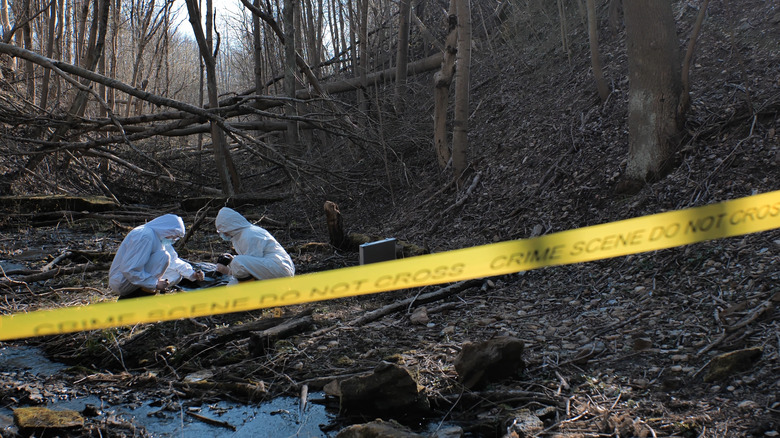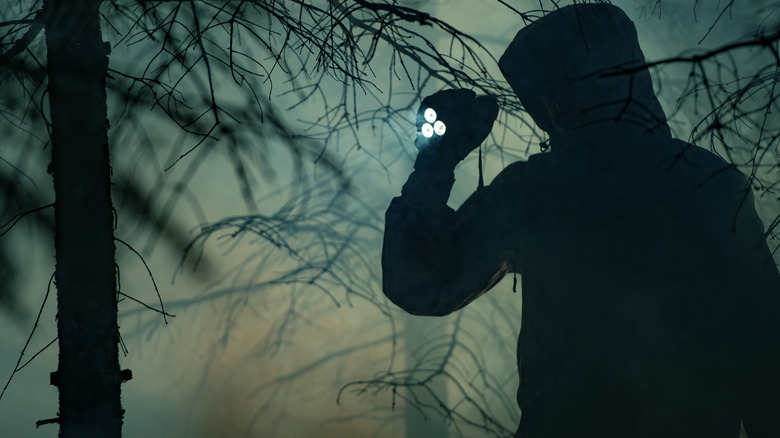These Two Murders Changed The Way The FBI Works Forever
The Jaeger family's dream vacation was in full swing by Sunday, June 24, 1973, as they enjoyed the beautiful scenery at the Missouri River State Monument Campground near Three Forks, Montana. Marietta and Bill, along with their five children, aged 7 to 16, had driven from their home in Michigan to Montana to explore the state where they were considering moving, according to Rachel King's 2002 book "Don't Kill in Our Names: Families of Murder Victims Speak Out Against the Death Penalty." Susie, the youngest, had light brown hair, hazel eyes, and a big heart. The three youngest kids were in a tent together that night. But by the next morning, there were only two left, according to the book.
Susie Jaeger's mysterious disappearance wasn't the only such crime around Three Forks, a small city in rural southwest Montana. In the late 1960s, there had been two child murders (per "Don't Kill in Our Names"). Was there a serial killer prowling for young victims in Three Forks? To find out the answer, the FBI relied on a new and untested technique that helped transform the agency's method of tracking down serial killers and other criminals, per A&E True Crime.
Other Mysterious Crimes Plaguing Three Forks
In the middle of the night, someone had snuck into the campsite, cut a hole in the tent's side, and abducted Susie Jaeger, per "Don't Kill in Our Names." Her teddy bear and a stuffed reindeer she always slept with were found nearby. A massive search involving local law enforcement and townspeople turned up no clues, according to The Billings Gazette. Four years earlier, an eerily similar crime rocked the area. At the time of Susie Jaeger's kidnapping, that crime remained unsolved.
In May 1968, at the same campsite, someone attempted to abduct a 12-year-old Boy Scout named Michael Raney by cutting through his tent and yanking him out, per The Billings Gazette. A fellow Scout found Raney with a head wound and bleeding from his side where he'd been stabbed. The young man died two days later. Before that, in March 1967, someone had shot and killed a 13-year-old boy named Bernard Poelman while he played on a bridge in nearby Manhattan, just down the road from Three Forks. The killer dumped his body in a nearby river, per The Billings Gazette.
The FBI Takes the Case
The local police called in the FBI early on in the case when it looked like someone had kidnapped Susie Jaeger. While the FBI can only investigate federal crimes, it can step in for cases of child kidnapping, per the agency. Special Agent Byron "Pete" Dunbar, who had grown up in Three Forks, handled the investigation. Dunbar had earned a law degree before becoming a federal agent, according to his obituary in the Belgrade News. He'd worked at various FBI field offices, including in Washington, D.C., and New York City, before returning to Montana. Dunbar knew the Three Forks area and the locals.
Three days after Susie Jaeger went missing, the family received a call from someone in Colorado who claimed to be the kidnapper. A month later, the man called again, demanding $50,000 in ransom, but didn't give any instructions (via "Don't Kill in Our Names"). For weeks afterward, there were no more calls. Meanwhile, Dunbar made his way through potential suspects, including a 24-year-old U.S. Marine recently back from Vietnam named David Meirhofer, per the New York Daily News. But Meirhofer was from a good family and was a decorated veteran. He didn't seem to be the guy.
Another Missing Person
The Susie Jaeger case stalled. On February 9, 1974, a 19-year-old woman from the area also went missing. Sandra Smallegan went to a basketball game in Manhattan, Montana, stopped by the American Legion bar, then headed home to her apartment, according to the Associated Press and the New York Daily News. By the next morning, she had disappeared. A week later, after an extensive search, police located Smallegan's car hidden at an abandoned homestead outside of town, per The Billings Gazette. Investigators also turned up human bones at the site that turned out to be the remains of Jaeger and Smallegan.
Special Agent Byron Dunbar continued his investigation and reinterviewed potential suspects, including David Meirhofer. The former Marine was unflappable and even agreed to a polygraph test that he easily passed. Dunbar left Montana and headed east for a required training course at the FBI Academy in Quantico, Virginia, per A&E True Crime. While there, he attended a workshop given by Patrick Mullany and Howard Teten. Their meeting would be a watershed moment for a new method of identifying serial killers and related criminals.
What was the FBI's Behavioral Science Unit?
Beginning in 1972, a small group of FBI personnel began offering courses at the FBI National Training Academy on the use of behavioral science in law enforcement, according to "Inside the FBI." Dunbar convinced members of the Behavioral Science Unit (BSU) to help him with his case back in Montana by compiling a criminal profile of the potential suspect, per A&E True Crime.
Patrick Mullany and Howard Teten, working with a third member of the BSU, Robert Ressler, poured over the evidence Dunbar sent them and came up with a psychological portrait of what the killer might be like, according to Psychology Today and the New York Daily News. They determined the killer was most likely a white male, local to the area, worked alone, and had spotted an opportunity to abduct Susie Jaeger. The killer would also be a great liar who would continue to contact the victim's family. They suggested the family record their calls. The BSU members also believed the suspect had military training.
A Killer Caught Using A New Method
On the one-year anniversary of Susie Jaeger's disappearance, the killer called the Jaegers and spoke with Marietta. "You wanted to talk to me? Well, here I am. I have Susie," she recalled him saying, per "Don't Kill in Our Names." She recorded the hour-long call, but an FBI trace failed. It didn't matter. Between the profile and the killer's recorded voice that matched one suspect, Special Agent Dunbar believed he had his man: David Meirhofer. Following his arrest, investigators found a severed hand in his refrigerator, per the New York Daily News.
Even with the psychological profile and the other evidence the FBI used to catch Meirhofer, it took Marietta Jaeger having a face-to-face conversation with the suspect before he confessed to the crime, per A&E True Crime. Meirhofer admitted he'd strangled Susie Jaeger to death and also confessed to the three other killings, according to ABC News. Afterward, Meirhofer went back to his jail cell and died by suicide. When the BSU aided Dunbar with their criminal profile, the higher-ups in the agency hadn't approved it, but thanks to this case and others, the FBI eventually adopted this and other techniques created by the unit, per Publishers Weekly.
If you or anyone you know is having suicidal thoughts, please call the National Suicide Prevention Lifeline by dialing 988 or by calling 1-800-273-TALK (8255).





